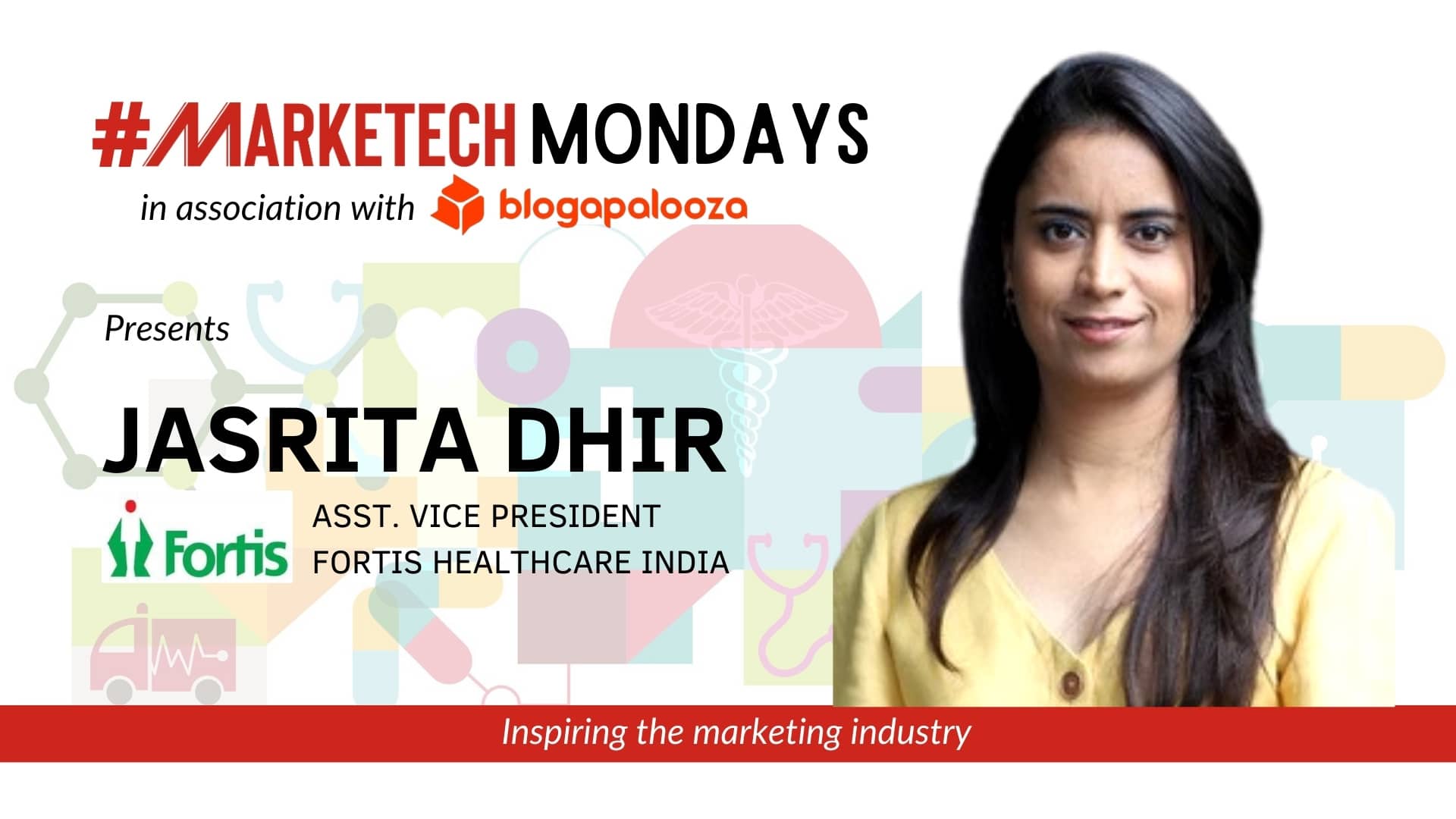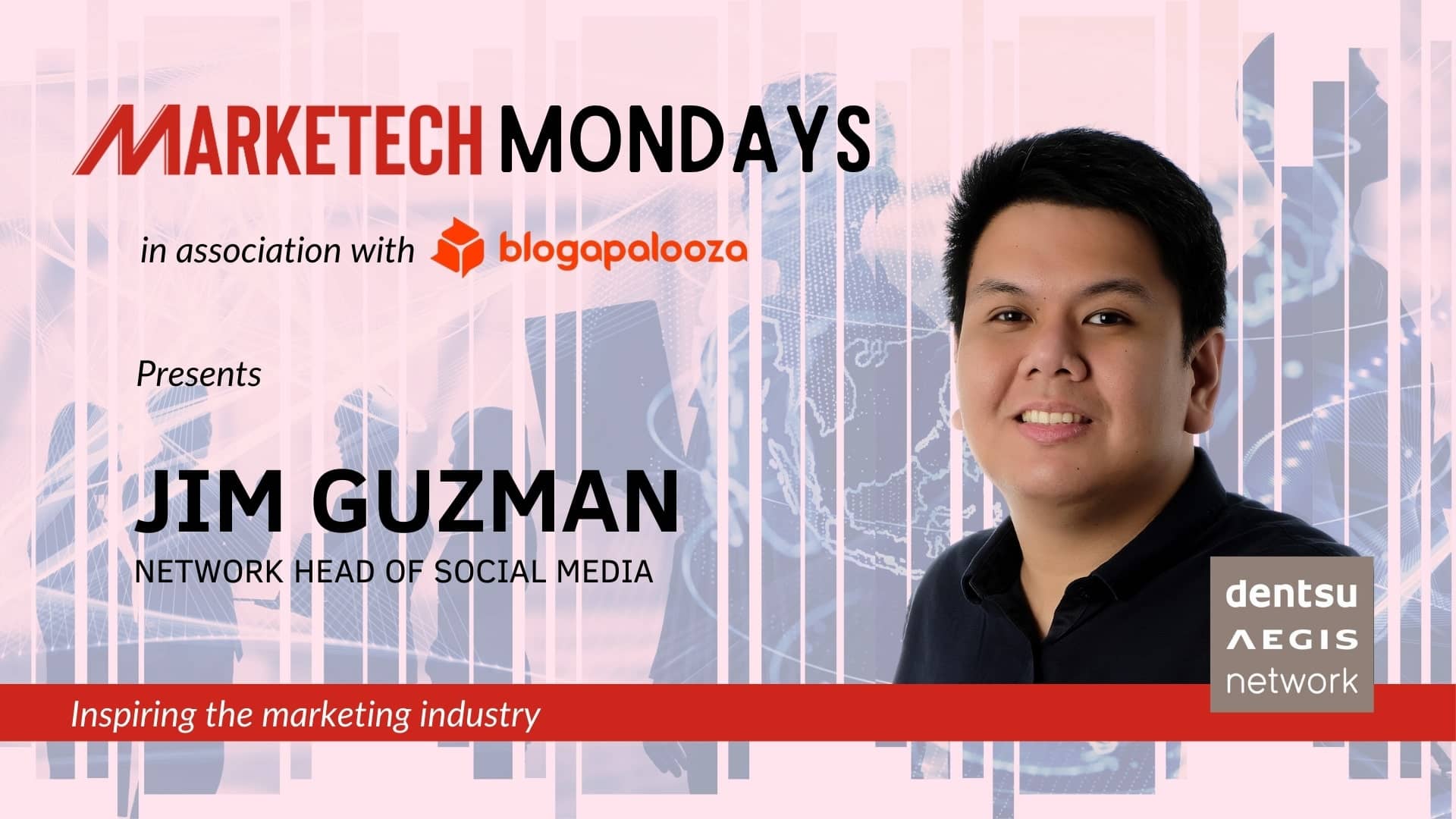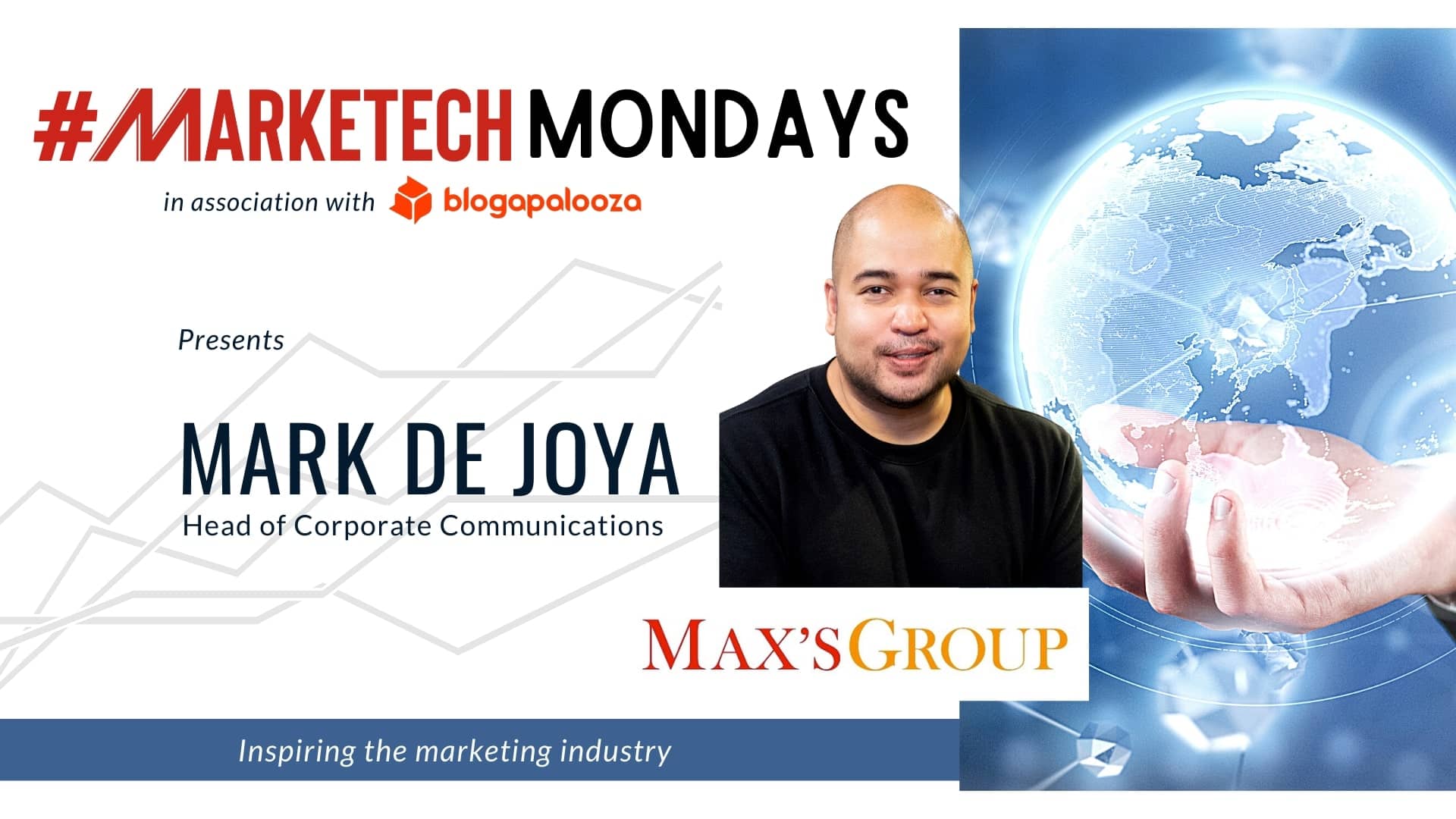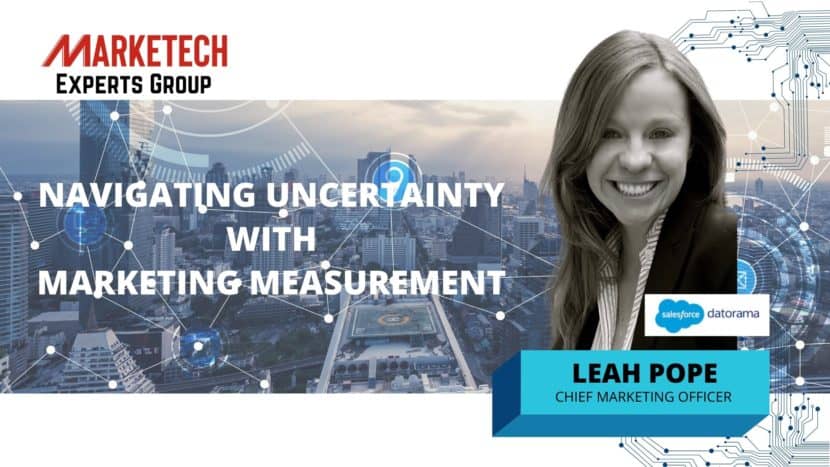For the third episode of #MARKETECHMONDAYS, MARKETECH APAC and Blogapalooza conversed with Jasrita Dhir, one of the most coveted women marketing leaders in the healthcare sector in India.
#MARKETINGMONDAYS is an interview webisode every second and fourth Mondays of each month, where we showcase inspirational marketing leaders to impart their journey as well as their insights into the field, and their advice for budding marketers in the oftentimes challenge-filled, but undeniably dynamic world of marketing.
Jasrita’s marketing journey stretches a long two-decade integration into the craft. She has worked with companies such as Procter & Gamble, Oberoi Hotels and Resorts and NDTV before having focused entirely on brand and marketing for healthcare services.
She was the woman behind some of the successful marketing strategies of healthcare services at Max Healthcare, and later on at Fortis Healthcare.
Having walked the path to eventually becoming a highly-regarded marketing leader, she admits that at the end of it all, the thing that matters the most isn’t the glamour and luster of brand ownership; but goes back to the simple reason of why you chose to become a marketer, that is, the ability to impact and make better the lives of consumers.
First ever dip into marketing
Ever since Jasrita stepped into the professional world, her career journey has always trailed the direction of marketing, particularly in healthcare brands. Her first job in the field was as a marketing communications manager at Max Healthcare, one of India’s biggest healthcare service providers. Five years prior to such post, she was immersed in direct marketing or sales for Procter & Gamble, where eventually the calling to endeavor in more creative work is what pulled her to fully take a shift.
Chance did not take it easy on her, debuting as a marketing woman. For her first project: a campaign to launch the flagship facility of the company in the upmarket residential colony of South Delhi, Saket.
Truly an intimidating assignment for a freshie, the weight of variables involved proves it to be far from sweet and easy. Four newly hired department heads at the time, each with a different institutes to be launched.
“I had to work on the entire stack of marketing communications of the flagship facility of Max Healthcare that they were launching. It was their biggest facility which is in Saket in South Delhi. There were four very senior doctors who were hired; their institute collaterals had to be made, each one of their institutes had to be launched, and then the overall hospital had to be launched,” said Dhir.
“From the pre-launch buzz, to the launch day, followed by the post-launch sustenance phase, and all of that, that was my big, first campaign; a trial by fire.”
Her first ever campaign may have had her grappling, but such was what ultimately grounded her fundamentals into the work of a marketer; launching her into a career that would later on, expand over a decade, where she now finds herself as the AVP for brand and marketing at Fortis Healthcare.
The intricacies of healthcare marketing
Marketing in healthcare separates itself from other types of marketing. When one’s mind touches on marketing, it is easy to immediately think of it in terms of a tangible product that is being promoted. But in healthcare, one of those products is a doctor – a highly skilled individual.
Having been into this subfield of marketing for almost 2 decades, Jasrita knows all too well of the technicality of being tasked to own a brand of healthcare nature, and says that there isn’t any other way to thrive but to “roll up one’s sleeves.”
“When you get into healthcare, you have got to understand that healthcare is a technical field. If you are not a doctor yourself, you have to get your hands dirty. You have to understand your product, your product is the doctor, your product is a highly-skilled individual, whose time is at a premium. So you have to put in the effort that goes into understanding your product and educating yourself,”
And by getting your hands dirty, she means shadowing the doctors, even if that requires you to be in an operating room yourself.
“You get to learn while being with the doctors in their OPDs, be at the operating theatre [and] see how a surgery is done, and then talk about it, then market it.”
Cause-based Marketing: Campaigns that don’t merely plug a product
Jasrita mainly describes herself as passionate, and for her, to do something is to do it with passion, and with heart. With her identity as a marketer, cause-based marketing had become her personal advocacy. For her, the field is not just an avenue to promote a product but to impact lives – the lives of the consumers.
When asked about the most memorable campaigns under her watch, the notable ones that came about weren’t those that have product plugging as the main aim, but projects that have advocated behavioral change, and those that as a result, have actually helped save lives.
Around 2015, Fortis Healthcare launched the #MoreToGive campaign, with an objective to encourage more Indians to donate their organs. The nationwide campaign was based off data from WHO that in India, the organ donation rate fares far from well with only 0.5 donors per million (at the start of the campaign).
The campaign adopted influential and famous ambassadors from different fields – war veterans, movie stars and sports personalities – to encourage civilians to pledge their organs. And after 3 years the needle has been pushed from 0.5 to 0.96 donors per million, and people who were actually waiting for a crucial organ donation were able to receive one.
Another campaign that Jasrita is quite proud of is the twitter campaign called, “Unmute yourself;” targeted to encourage people dealing with depression and mental illnesses to open up and jumpstart a healing process.
She says there is nothing more “Immensely gratifying” when you as a marketer are able to do something to make the world a more livable place. One of the groups of people predisposed to such campaign were students who are susceptible to suicidal tendencies during exams time.
Advocacy-focused marketing as Jasrita lives by, meant staying true to the sincere and genuine purpose of helping people and spreading awareness on issues that truly matter. For the “Unmute yourself” campaign, personalities who had experienced real-life struggles with mental health such as sports personalities as well as film, and movie stars were tapped to lead the forefront of the advocacy, bringing the message that anyone can be impacted by mental health issues.
Jasrita’s Marketing Heroes
Having lived and breathed healthcare as a marketing strategist for many years, Jasrita’s most inspirational mentors were mostly doctors. One is former regional director of Fortis Healthcare and now founder of healthcare concierge service medECUBE, Dr. Dilpreet Brar.
Jasrita’s relationship with Brar has been first forged during her days at Max Healthcare where the two have worked together. After some time, Brar would transfer to Fortis where Jasrita would later follow, adding in sum almost 12 years of a working relationship for the two.
What she admires most about Brar is what may come off as a paradox, but one that couldn’t be more true to her approach to work, and that is, the esteemed doctor’s “fiery brand of leadership coupled with empathy”.
“She is this person who has empathy for the team, for the patient, and for the consumer. Part of what she brings to the table is her no-nonsense, no-holds-barred, “what you see is what you get” brand of leadership,” Jasrita said.
Jasrita also speaks of Brar’s one-for-all, all-for-one principle.
“As [she] moves along [her] career, [she takes her] entire team along with [her]. And as a woman leader, when you reach up there, you also [have to lend your hand] to the ones who are coming up there and helping them. That is something that I love about her.”
What makes Brar a sought-after mentor for Jasrita is that she hurdles one other thing: the never-ending disparity of gender in leadership roles.
“There are just so few women leaders. When we enter the corporate board room, there are hardly any women there to look up to, and then you see a woman like this,” she said.
Another person that Jasrita has been greatly inspired by is Fortis Healthcare’s ex-CEO Bhavdeep Singh. And she tries to take after the man for the simplest reasons, but one that is still lacking in most leaders: leading by example.
“He was the most hardworking person on the team, whichever team that he was in, he is my most hardworking CEO ever.”
“[He leads by the principle wherein] ‘I’m not going to ask you to do something that I won’t do. I’m only asking you to do what I’m doing.”
As a proponent of women empowerment and leadership, another of Singh’s characters that strikes her as commendable is how as a male leader himself, Singh could genuinely advocate women to have more seats at the table.
“And he was a great proponent of women leadership, not just by mere lip service, but by action”
“Be the consumer’s voice”
When we sat down with Jasrita, she relentlessly spoke of marketers being the consumers’ voice throughout the interview, and finally, when we asked her of her ultimate advice to young would-be marketers, she uttered the same snippet of wisdom: represent the voice of the consumer.
She explains why:
“As marketers, we need to have a pulse on our consumer, on the economy, on the market. You are the eyes and ears of the marketplace to the organization,” she said.
“You are the consumers’ voice inside the boardroom. No matter how unpopular it is, no matter how harsh it is. There will be times when the consumer is disillusioned with your brand, dissatisfied with your brand.”
“Speaking truth to power is something that comes very naturally to me. And this is something that I have chosen, that I will be that consumer’s voice in the boardroom.”
Another advice that she wants to give to marketers, which right off the bat, can be said to be a true life advice, marketing folk or not, is to continually upgrade oneself.
She speaks anew of now the proverbial “pulse” of the consumer:
“Keep upgrading; it’s nobody else’s responsibility to upgrade your skills. Because your consumer is going to keep changing; there are new avenues, there are new mediums, [and] there will be new platforms. You have to have their pulse.” Finally, she shared how such a growth mindset can jumpstart, at the same time, keep it grounded for the years to come. ”If you keep upgrading, you will keep your creative juices flowing, and you will be a marketer who’s in demand always.”
Subscribe to MARKETECH APAC’s YouTube Channel and watch the full video interview with Jasrita as we premiere tomorrow, August 24 at 5 pm (PHT).
If you’re a marketing leader and you want to share your career experience to inspire the marketing industry, please reach out, we want to hear your story.




